The Writing Spider (Argiope aurantia) is a spider of many names. Known as the Yellow and Black Garden Spider, Golden Orb Weaver, Yellow Argiope, Corn Spider, Scribbler Spider, Golden Garden Spider, and Black and Yellow Argiope, just to name a few.
Despite its many identities, this is perhaps one of the most easily recognized species of spider found in gardens all across North America. It is found in the contiguous 48 states, and Canada, although rare throughout the Rocky Mountains in Colorado, and parts of Canada’s Great Basin.
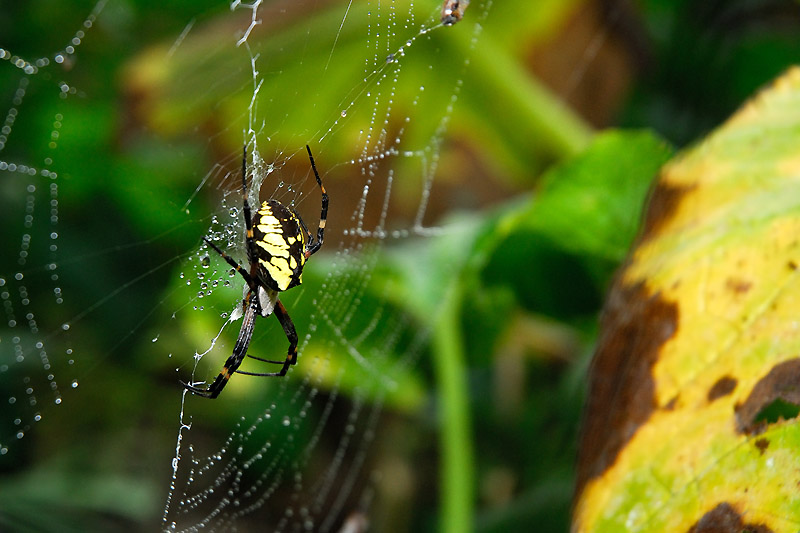
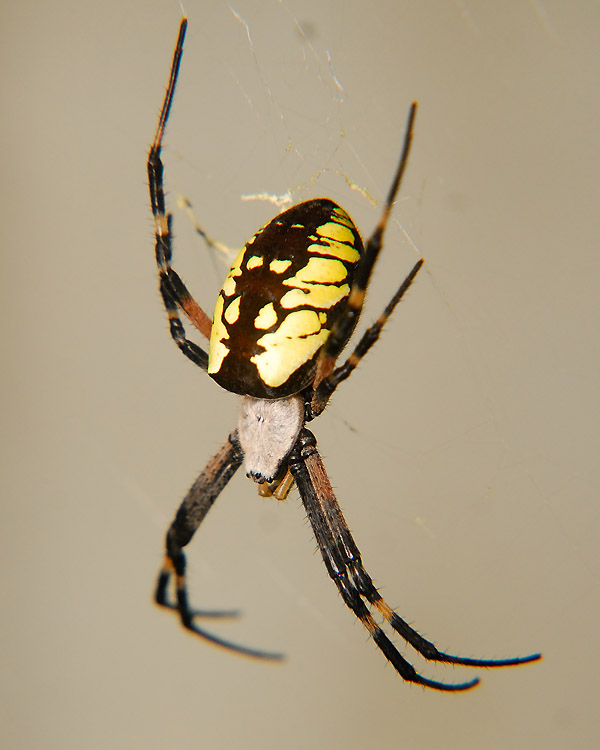
As plentiful as the common names for this species are, the epithet for this species is appropriately descriptive. The yellow and black markings on the abdomen of this species are distinctive, but the genus name, Argiope, means ‘silver face’, referring to the fine silver colored hairs found on the cephalothorax of the spiders in this genus.
The species epithet aurantia means ‘golden’, and does refer to the vivid golden yellow markings on the abdomen.
The remnants of our squash patch, where we conducted Our Great Heirloom Squash Experiment this year is now home to this particular female.
There are many species of orb-weavers, the spiders responsible for constructing the truly beautiful, classical spider webs seen in almost every garden.
When I first encountered this female, it was late in the afternoon. She was sitting perfectly still, directly in the center of her web, patiently awaiting her next meal.
The lighting was poor though, so I made a point of revisiting her the next afternoon.
As I approached her web the next day, the first thing that caught my eye wasn’t the spider, but the half dozen cocooned honey bees, neatly packaged, and stored on the web’s silks.
Her web that afternoon was showing significant signs of wear, no doubt due to the number of honey bees that had become trapped in it during the course of the day.
This species of spider deconstructs, and reconstructs her entire web every day.
The web itself can exceed 2 feet in diameter, and is intricately engineered. To see her web at its best, I visited her again early the next morning. Here it is beautifully reconstructed, in minute detail, ready for another day ensnaring prey.
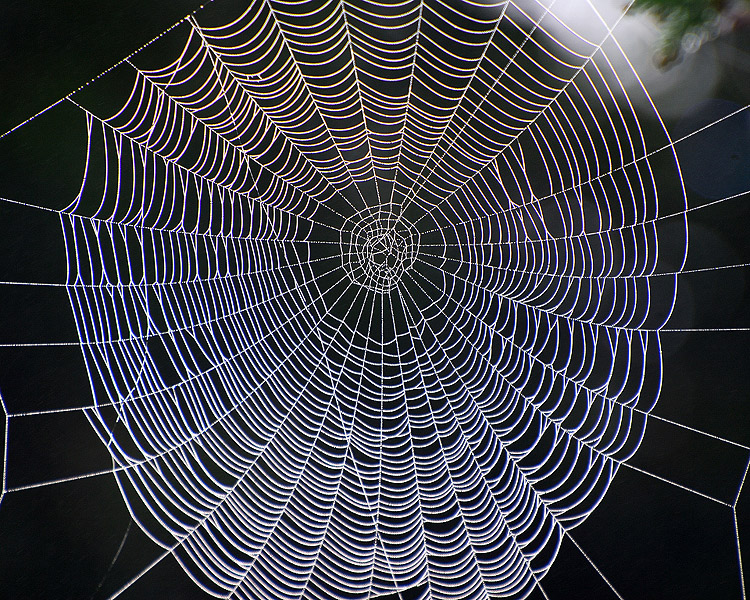

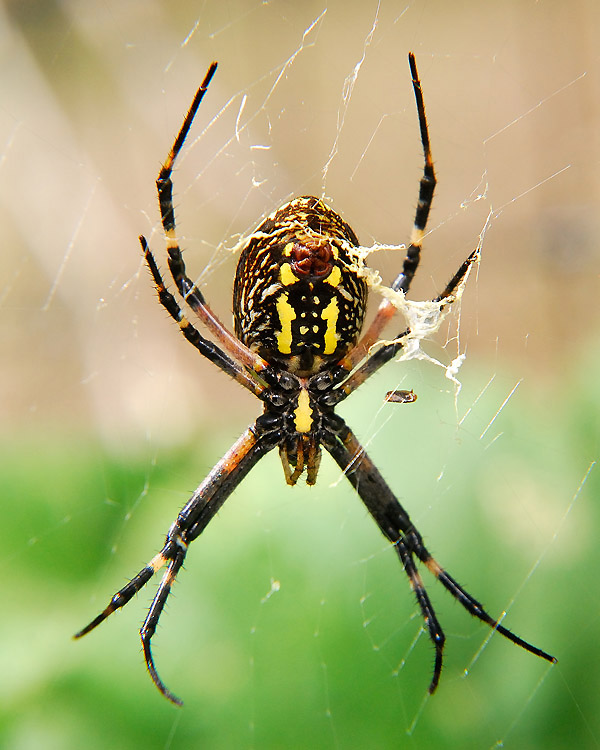

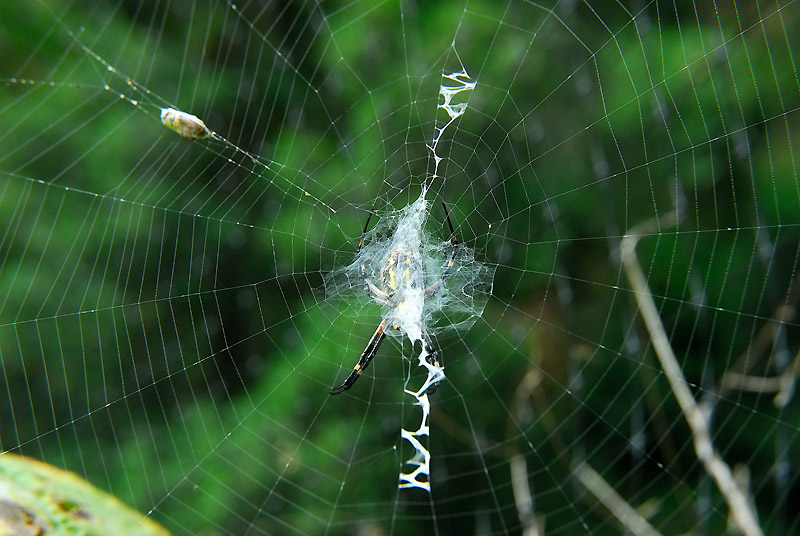
Of all the common names given to this species, I find Writing Spider to be perhaps the most descriptive.
These orb weavers are called Writing Spiders for the series of X’s, or zig zags, that are constructed throughout the center of the web, called stabilimenta. These can vary from one Argiope species to the next, even between spiders of the same species. Sometimes these patterns may be vertically aligned through the center of the web, or even circular in pattern. To our eyes these patterns are distinctive, but merely decorative. However, it has been argued for many years as to the function of these patterns within the web.
It was once presumed these zig zag fibers were responsible for helping to structurally stabilize the web. However, these stabilimenta are embellishments, added after the main web is complete, over the top of the existing fibers, and as such are now thought to not contribute much to the overall stability of the web at all.
As orb-weaver webs containing stabilimenta have been shown to catch more prey than webs without them, it was thought that perhaps the stabilimenta were able to specifically attract prey insects to the web. Some theorized that the stabilimenta scribbled in the center of these webs reflected more UV-light than the surrounding silk fibers, therefore making the stabilimenta more alluring to pollinating insect species.


Most gardeners know that flowers exploit the principle of reflecting UV light to attract insects to their pollen stores. This is how flowers ensure they will be visited, and pollinated, and in return they reward visiting pollinators with nectar.
However, this theory of UV-reflecting stabilimenta, although plausible, was cast into doubt in 2002 by Zschokke, who found the stabilimenta were not any more UV-reflective than the silks used to construct the rest of the web [1].
As such the stabilmentum, the entire web, may in fact be poorly perceived by insects. However, as the stabilimenta are readily perceived by birds, it was proposed that their function may be more for defense against birds, to prevent them from flying inadvertently through the web, rather than attracting prey. Regardless, the true function of the stabilimentum remains controversial.
Instead, it may be the bright color of the spider herself that is most alluring to her prey. One recent study showed that brightly colored Argiope spiders catch more prey than those where their coloration was experimentally shielded, or altered.
Prey insects apparently can percieve the vivid colors on the abdomens of spiders in this genus very well, but not the muted yellow and black banding on the legs [2]. As such, potential prey don’t perceive the overall shape of the spider on the web, at least not until it’s too late.
The yellow and black coloration of this species may also help this spider to resist becoming prey herself. A vertebrate predator that has learned to avoid similarly colored insects, such as wasps, may also avoid this spider due to the vivid yellow and black pattern on this spider’s abdomen.
This particular spider had constructed her web between some squash leaves, and part of our perimeter deer fence around the orchard. During one of my visits I managed to work my way around so I could position myself almost directly in front of her. As I sat there, patiently trying photograph her face, she suddenly darted straight down the center of the web. She’s a very large spider, the largest I’ve seen here of this species, and as I had a macro lens on the camera, her sudden movement startled me. Up until now, she’d been completely motionless.
Fortunately I didn’t take my eye away from the viewfinder though, as within just a few brief seconds she had caught, and entombed the prey that had landed squarely in the lower-center of the web.
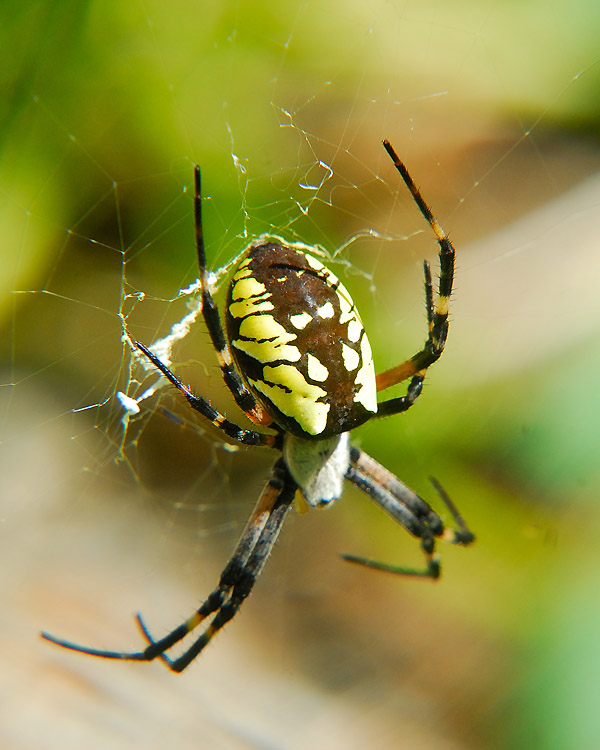

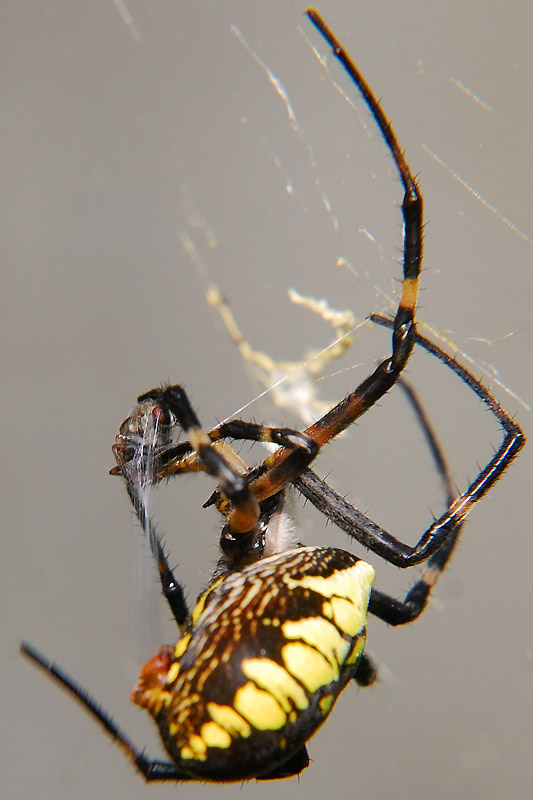


She swiftly, and adeptly turned her prey, wrapping it snugly in a multi-stranded sheet of silk, and once it was secure, she immobilized it. This species, like many spider species, injects venom in her prey to immobilize it. Note however, although she uses venom to incapacitate her prey, this spider species is not harmful to gardeners, and is a very beneficial species of spider in the garden.
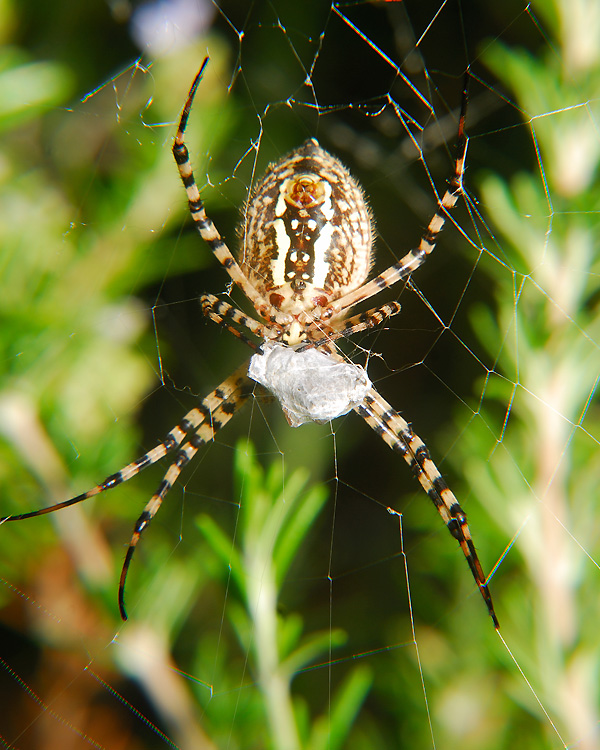
Unlike the bees, that she saved for later meals, this fly was dined on almost immediately, and then discarded. Perhaps just a light mid-afternoon snack.
As large and formidable as this spider is, she is nearing the end of her life. Before the first frost she will need to find a mate. Males of this species, as with many other species of spiders, will not survive breeding. In fact, this species is unique in that the males die during copulation, spontaneously, while attached to the female [3]. This helps to ensure the passage of his genes to the next generation, and prevents other males in the vicinity from mating with the female. Soon after death though, the female will entomb the male in silk, just as she would any other prey, and he in turn will be consumed.
The female will hopefully soon lay her eggs, which will be wrapped in an intricately woven protective silken sack, at which time her work will be done. As she won’t venture far from her web, we’ll continue to watch for signs of eggs over the coming weeks. This short clip shows you what we’ll be looking for:
Unfortunately, the female will not survive once the cold winter weather sets in. However, if her young avoid predation, they will hatch over winter, within the sack, and not emerge until the first warm weather in spring, when they will finally disperse, to begin the cycle again.
———————
[1] Zschokke, Samuel. 2002. Ultraviolet Reflectance of Spiders and Their Webs. The Journal of Arachnology 30:246-254
[2] Bush, Alex A., Yu, Douglas W., and Herberstein, Marie E. 2008. Function of Bright Coloration in the Wasp Spider Argiope bruennichi (Araneae: Araneidae) in Proceedings of The Royal Society B. 275:1337-1342.
[3] Foellmer, Matthias W., and Fairbairn, Daphne J. 2003. Spontaneous Male Death During Copulation in an Orb-Weaving Spider. in Proceedings of The Royal Society B – Biology Letters. 270:S183-S185

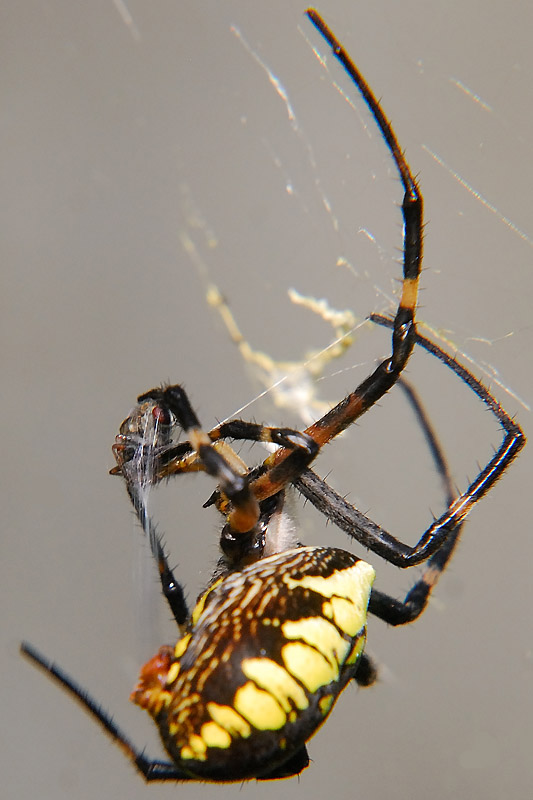
What great macros Clare and what a beautiful web she weaves especially with those zig zags that she weaves through her final masterpiece.
I wonder if those bees came from your hives?
Sadly, I’m fairly certain those are our bees. This web isn’t very far from hives, and I frequently see the bees still foraging for pollen under the web in the few squash blooms that are still being produced. However, these are summer bees, and only live for a few weeks. During this time of year a lot of the summer bees die off, and are replaced by the longer lived winter bees. If they’re going to die, they may as well help to feed other creatures in the garden. Judging by the size of this female they must be very nutritious 😉 No doubt they’ll help this spider to produce lots of young spiderlings!
Clare, I am always so fascinated with nature: observing, seeing things for the first time, attempting to understand how something came to be… and am always absolutely amazed with the various habits and life cycles, i.e. the salmon. Die during copulation… well, I wasn’t ready for that.
Beautiful spider and the artwork she weaves! Thanks for the lesson. You are a wonderful teacher.
That’s ok Diana, I was quite surprised to read of the male’s demise during copulation as well. I suppose it’s better than being conscious when the female chooses him as the main entree 😉 I’m always fascinated by the various methods nature employs to ensure the production of the next generation of a species. This one I admit though is a little dramatic, but effective!
Too many names perhaps but a helluva spider.
She is indeed, and plenty large enough to wear all those names, well. It does prove the value of Latin names though, with those there’s no doubt who she is!
Dear Clare, I really appreciate the thorough research you made for this posting. Very informative! And your photos are first class. I agree writing spider is the best name for her. P. x
Thank you Pam 🙂 It’s amazing to me that she rebuilds that massive web every day. I wonder if she always writes the same thing in the center of her web. Maybe I’ll take a peek this morning to see…
I love seeing these spiders in my garden. Thanks for all the information about her! I never thought about her being so pretty she herself would attract insects, but it makes sense they might think she was a pretty yellow bloom! When I saw she had been encasing honey bees I thought, “Uh, oh, she’s in trouble!”. Sorry about your bees. But I loved seeing the spider!
I hadn’t thought that the marking on her would be potentially attractive to prey either. That insect prey can’t make out her shape though makes that theory make more sense. She’s not in trouble for nibbling on the bees. This time of the year the hives are ‘downsizing’ their population to prepare for winter. Less bees, means they need less food reserves to survive the winter months. I think of this spider as part of the clean-up crew 😉
Very informative again Clare. We get these spiders frequently, but I never saw a bee captured in the webs. I enjoyed your images very much.
This lady loves her bees! I’m sure that she’s catching so many because our hives are so close to where she’s built her web. Almost every time I walk by her now there’s at least one neatly packaged bee in storage.
Fascinating but creepy too. Spiders who are coming indoors have been biting me of late so I am none too fond. I give them a wide berth in the garden too. I found a honey bee trapped in a spider web in the garden this fall. Seems to be a wolf spider. I have not encountered this spider in the garden. Incredible pictures Clare
You’d certainly know if you bumped into this spider, or one of her cousins. They’re difficult to miss, and quite a bit larger than most other spiders lurking in the garden. There’s a similar species I’d love to see, the Banded Argiope (Argiope trifasciata), also a widely distributed species. We have them in California, but I haven’t yet bumped into one in the garden. Looks very much like this species, but the abdomen is striped instead of spotted.
Hi Clare – wow, I learned a lot – We had one a few years ago and I loved watching her – but never before or since. I wonder why I don’t see them more? Glad you got picked up by Dirt Du Jour – congrats – well deserved!
I was asked two years ago by a friend, shortly after I started the blog, if I’d feature one of these spiders in a post. That year we had one build a web across a large lavender plant near the front door. I didn’t get organized enough to post it that year, but planned to last October. The only trouble was, I couldn’t find one of these spiders anywhere! I don’t know why we tend to see them more some years than others. They certainly don’t seem as plentiful as some of the smaller species, and this fall so far, I’ve only found her here. October is definitely the month we notice them though. They do like very open and sunny locations, and most of our property is heavily wooded, which is probably why when we do find them, they’re in the garden. Maybe now we have bees, which seem to be a favorite snack item, we’ll see them more often 😛
Great post Clare. We had a couple of these spiders in our garden last year and it was my first time seeing them. After reading your post now I know a few more of the facts about them. There was an egg sack left behind last year by our female but it was blown away in the winter winds and I haven’t seen a single spider this season. I’ll cross my fingers they reappear next year.
That’s my concern if this female produces eggs. She’s at the edge of the squash patch. As I’m still waiting for a few large squash to ripen, we’ll leave her be. If we do see eggs by the time we’re ready to remove the last of the plants, we may have to relocate them to somewhere safe.
Wonderful post! Did you know these spiders also used to be called McKinley spiders, because someone had claimed that one had spun the name “McKinley” into its web, thus predicting the election of the 25th president? Once you begin watching spiders, they pose more and more questions and present more and more surprises. Blatant self-promotion here, but if you’re interested in spiders and their silks, please check out Spider Silk: Evolution and 400 Million Years of Spinning, Waiting, Snagging, and Mating (Yale Univ. Press), by me and Catherine L. Craig. More info at http://www.lesliebrunetta.com
Thanks again for the great photos and commentary!
Thanks for stopping by Leslie. The name McKinley spider is new to me, I hadn’t heard of that. I was fortunate to see this female while she adding the stabilimenta this morning. At first I thought it was odd there were no zig-zags, but I’d just caught her after she’d completed the main web, but not yet ‘written’ on it. I wish I’d had my camera!
I see these in the all over the garden. Their webs are some of the most beautiful. Your post was so informative, and I learned much of what I did not know. Thanks!
I’m impressed at how large these webs can be, and every morning this week she’s patiently built a new one. I’m clearly not working hard enough, she puts me to shame! 😉
That spider is not seen in our area, or maybe i am just not observant to them. We have the big spiders which are more scary and get the attention. Thanks for informing us what they are called. Your photos are very splendid and detailed specially the web, which are very difficult for me to focus.
She may not be in your area. They are throughout most of North America, and parts of Canada, but there are some gaps in their range. Certainly if you saw one, you’d notice! They’re unmistakable.
Those are great photos of a very familiar spider! It’s a beautiful thing, though I guess not so much if you are its prey. 🙂 I had one build a web one time right across the door leading to the deck. I used another door to avoid destroying the web.
It seems that even if you’d inadvertently walked through it one day, it would probably have been back the next 😉 We’re being very careful not to disturb her at the moment. I’d love to see more of these spiders in the garden, although our bees might not! 😛
Hey there Clare, how are things? I have these spiders in my yard. 3 years ago when I first moved to Charleston, I ran into one of the webs and being all caught up, saw the architect and FREAKED out. Promptly ran into the house to look her up and discovered how completely harmless she was, and how ridiculous I was being. Since then I’ve appreciated them, they do weave some amazing things.
It’s an easy spider to freak out at, especially on a first encounter! The only spider I’ve seen here that’s larger is our native little brown tarantula. I say little, and it is small for a tarantula, but still big by my spider standards 😀 These writing spiders aren’t as large, but still big enough, and bright enough, to be attention grabbing!
Wow, this is very interesting, and I am amazed at your skill and patience in recording the spider’s activities. I believe I have seen this very same kind of spider in my own garden. Nature is fascinating to watch, but I would hate to be born male in this species! Seems gruesome, but I suppose that willingness to give one’s life for the future generation and for your mates sustenance is the epitome of true love. Some human males do the same thing, but not so quickly!
Yes, the males definitely drew the short straw. Nature does have some novel methods for ensuring the genes of certain individuals are passed on. I suppose it’s better to drop dead before she has to kill you though. The males of some species have that fly-eye view of the female’s fangs before they die 😉
Love seeing life through your eyes, Clare. I really must take a closer look at things that frighten me! (I AM in awe of spider webs)
I used to scream at spiders in the bath tub. Now they just fascinate me more than scare me. I agree though, their webs alone are beautiful, even if nobody is home! 🙂
you’d feel sorry for the poor honey bees but that’s nature in all it’s glory for ya! Great pics!